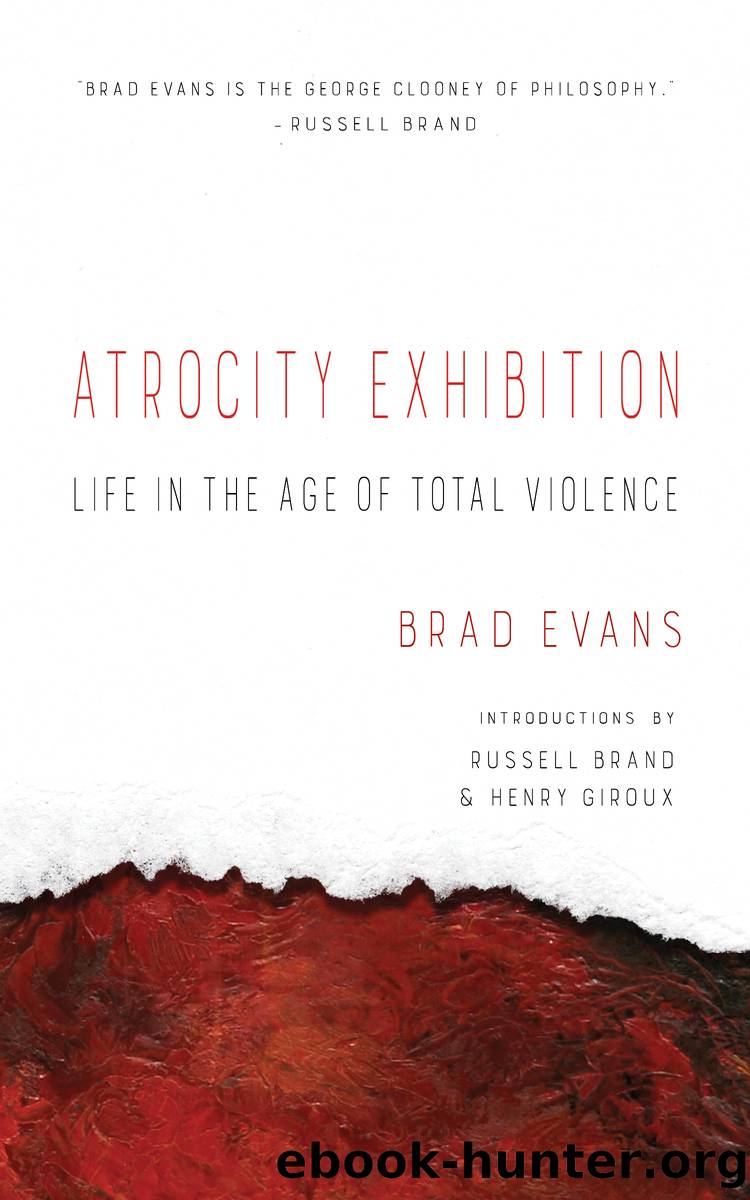Atrocity Exhibition by Brad Evans

Author:Brad Evans
Language: eng
Format: epub
Publisher: Los Angeles Review of Books
Published: 2019-06-15T00:00:00+00:00
Originally published in somewhat different form in TruthOut.
Facing the Intolerable
Brad Evans
Tuesday, 11 November 2014
JACQUES RANCIÃREâS Figures of History is the latest instalment from a serious thinker whose pioneering work engages with the politics of aesthetics in an attempt to reimagine the political as an art form. In Figures of History, Rancière offers an accessible introduction to the links between aesthetics and various regimes of power and the ways aesthetics is integral to thinking about who we are as people. He also provides a nuanced framing of the modern history of art, wrestling out the silenced and invisible from figurative enslavement. As Rancière writes,
If there is a visible hidden beneath the invisible, itâs not the electric arc that will reveal it, save it from non-being, but the mise en scène of words, the moment of dialogue between the voice that makes those words ring out and the silence of images that show the absence of what the words say.
Rancièreâs Anglo-American appeal is evidently on the rise: translations of his works are proliferating and his audience is growing in a broad set of academic disciplines. This has placed him in direct confrontation with two notable contemporaries: Giorgio Agamben and Alain Badiou. Rancière and Badiou both studied under the tutelage of Louis Althusser, and they both have affinities and animosities with Gilles Deleuze, although different ones. Badiou, for instance, largely rejects Deleuzeâs intellectual corpus, especially concerning the idea of âthe event,â which Badiou universalizes through his notion of fidelity to truth, including the truth of art, whereas Rancière does not. Deleuze, in fact, remains instrumental for Rancière in terms of his ongoing thinking of the political function of art through what he terms the âdistribution of the sensibleâ: aesthetics, for Rancière, is integral to the delimitation of spaces and times, including what is perceived as proper to thought.
Rancièreâs Figures embodies the tragedies of modernity. Our first glimpse of this appears on the cover, which features Larry Riversâs Erasing the Past II. Riversâs subtle erasure of the image of a Holocaust survivor (invoking all-too-evident connections with the cover art of the Abacus edition of Primo Leviâs If This Is a Man/The Truce) captures the authorâs contention that we must approach all representations of historical events with scepticism â questioning what is memorialized, what is erased, what is being shown, what is being slowly forgotten. History, he claims, should be rethought by attending to the hidden traces. Rancière writes, âhistory isnât done yet with turning itself into stories,â drawing upon a range of compelling examples from Francisco Goya, Otto Dix, Claude Lanzmann, and Zoran MuÅ¡iÄ in order to draw particular attention to the victims of historical forces. This allows him to explain how âfiguresâ represent the overt politicization of the truth of history while providing figurative displacements that allow for novel interpretations and the recovery of more complex narratives concerning histories of violence.
Every war produces its casualties. While these are often measured along some crude atrocity scale, as societies try to make statistical sense of the quantifiable levels of destruction (i.
Download
This site does not store any files on its server. We only index and link to content provided by other sites. Please contact the content providers to delete copyright contents if any and email us, we'll remove relevant links or contents immediately.
| Diaries & Journals | Essays |
| Letters | Speeches |
The Rules Do Not Apply by Ariel Levy(4842)
Bluets by Maggie Nelson(4472)
Too Much and Not the Mood by Durga Chew-Bose(4270)
Pre-Suasion: A Revolutionary Way to Influence and Persuade by Robert Cialdini(4142)
The Motorcycle Diaries by Ernesto Che Guevara(4008)
Walking by Henry David Thoreau(3892)
Schaum's Quick Guide to Writing Great Short Stories by Margaret Lucke(3316)
What If This Were Enough? by Heather Havrilesky(3270)
The Daily Stoic by Holiday Ryan & Hanselman Stephen(3227)
The Day I Stopped Drinking Milk by Sudha Murty(3157)
The Social Psychology of Inequality by Unknown(2935)
Why I Write by George Orwell(2874)
Letters From a Stoic by Seneca(2732)
A Short History of Nearly Everything by Bryson Bill(2627)
A Burst of Light by Audre Lorde(2545)
Insomniac City by Bill Hayes(2493)
Feel Free by Zadie Smith(2432)
Upstream by Mary Oliver(2335)
Miami by Joan Didion(2319)
